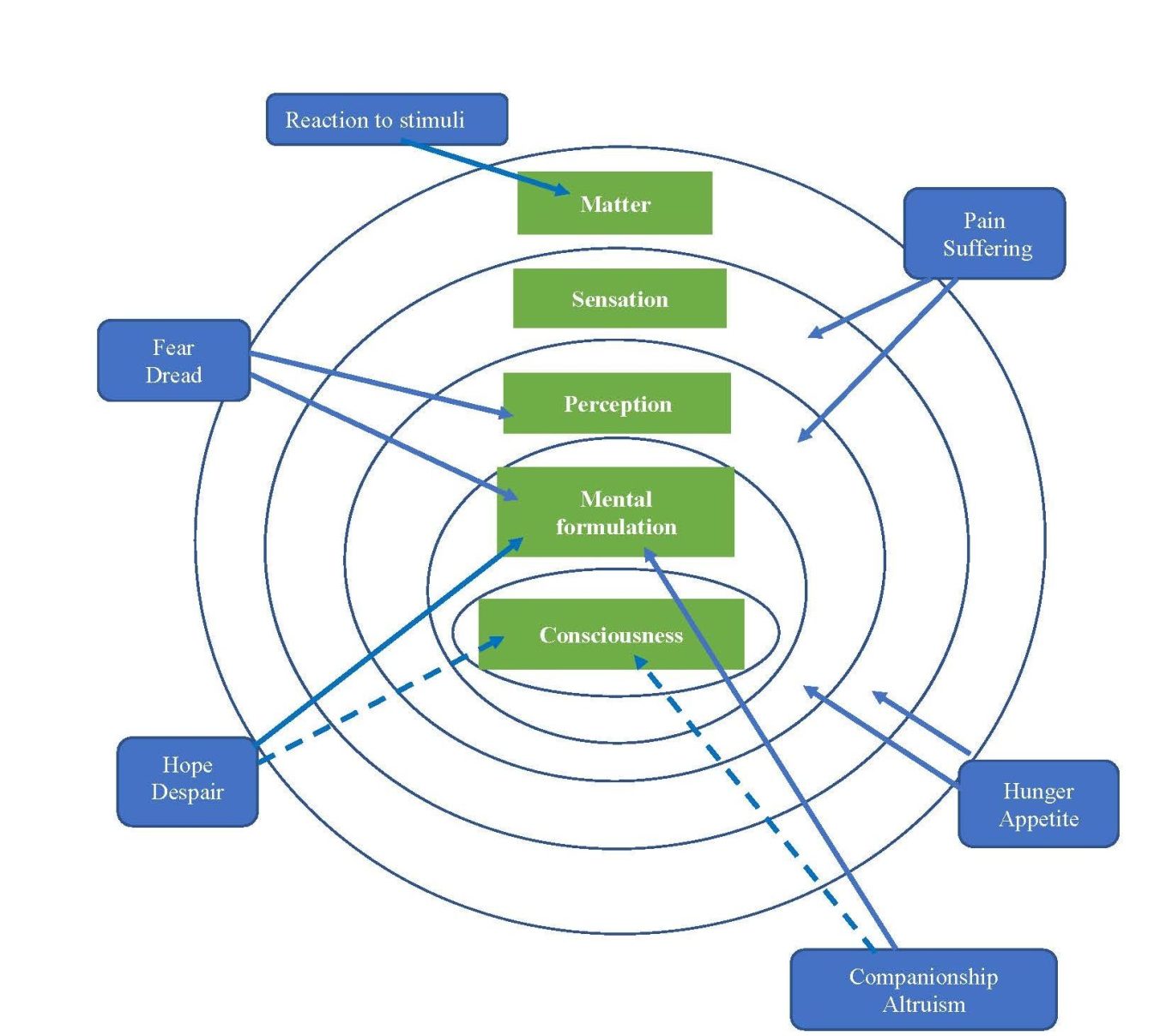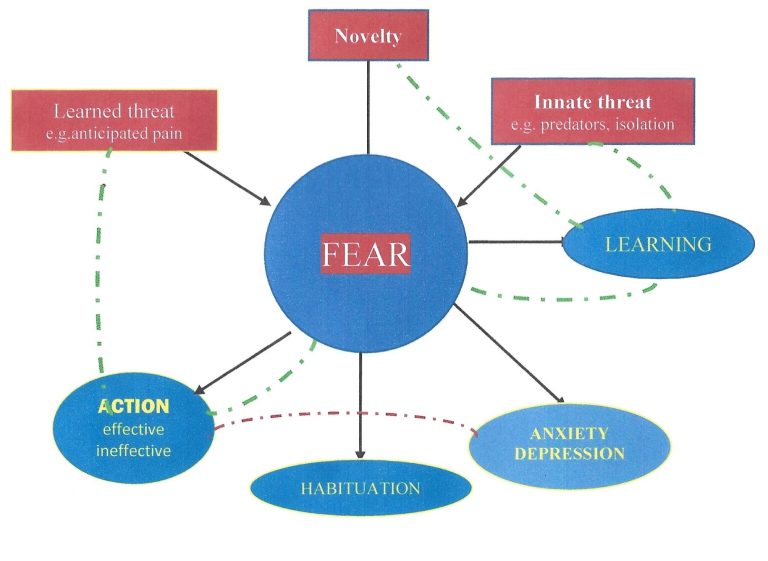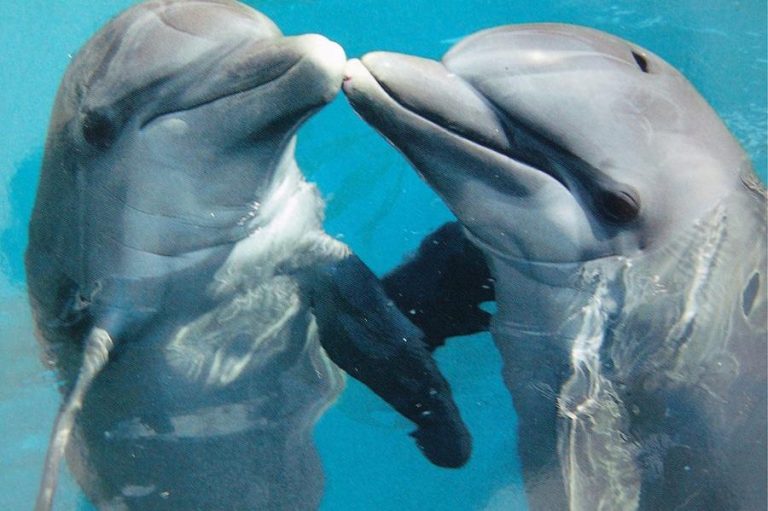Sentient Minds
All animals are sentient but some animals are more sentient than others. The five skandhas of sentience as described by the Buddha constitute, to my mind, the most scientific approach to the analysis of sentience, and degrees of sentience in life forms. These are illustrated in the diagram. It includes examples of a range of primitive and more complex sensations and emotions that may impact on one or more of the five skandhas. These are not intended to be definitive but presented as a basis for discussion. The dotted lines are very speculative.


Matter refers to all living forms, plants and animals that respond to environmental stimuli: (sunflowers turn to the sun, amoebae move away from an acid solution). At this level, it does not necessarily involve sensation.
Sensation Most international law and welfare codes of practice equate sentience with the capacity to experience feelings when exposed to states such as pain, heat and cold, hunger and thirst. These feelings may be aversive, attractive or unimportant. At this level of sentience, animals will be motivated to take action to adjust how they feel. By this definition, all vertebrates (mammals,; birds and fish) and an increasing number of invertebrates (cephalopods, some crustaceans ) are recognised as sentient, This number will increase as we lean more.
Perception describes the ability to register, recognise and remember. It gives the ability to learn from experience. Pain (in humans) has been defined as ‘an unpleasant sensory and emotional experience associated with tissue damage’. All sentient animals feel pain. Animals with sentient minds can suffer not only the direct effects of pain but also chronic anxiety through awareness of its recurrence from experience. Animals with the power of perception do not just live in the present. This increases their capacity to cope with the challenges of life but increases the potential for suffering if the stresses are too severe, complex or prolonged or if they are in an environment that restricts their ability to exhibit coping behaviour.
Mental formulation describes the ability to create mental pictures that enable animals to interpret and thereby get a fuller understanding of complex experiences, sensations and emotions. This not only enhances their ability to cope but also enriches their ability to pass on their skills to others, typically their offspring.
Consciousness (as described by the Buddha) is restricted to the deepest circle of sentience and may be defined as ‘being aware that we are aware’. The extent to which non-human species may exhibit this degree of sentience is uncertain, but may be of minor importance in the context of their welfare.
All sentient animal species experience stressful sensations such as pain, heat, hunger and thirst, as feelings and this motivates them to action to relieve them. Species with the power of perception and mental formulation learn from experience how to cope with these and other stresses. This enables them to adapt to the challenges of their environment. If they discover that they are unable to cope, they will suffer. Species with the powers of perception and mental formulation (cognition) have sentient minds. Not only can they feel, they can think. Their actions in response to sensations both good and bad is modified by cognition.
Evidence is accumulating to show that animals with powers of perception, mental formulation and, in a few examples, self-awareness (consciousness), show behaviour consistent with higher emotions. These may include Comfort and Joy, Hope, Grief and Despair. Animals that have adapted to life in groups display complex patterns of social behaviour. They include education necessary to adapt to the fitness of their society. Much of this behaviour is likely to be self-serving. However, some behaviour in some species may express empathy, concern, (including compassion) for others. If this is directed towards others with the same gene pool it cannot be said to be altruistic.
‘I would lay down my life for two of my children or eight of my second cousins’
J.B.S.Haldane
________________________________________________
SENSATIONS AND EMOTIONS
Pain and Suffering
Pain (in humans) has been defined as ‘an unpleasant sensory and emotional experience associated with tissue damage’. All sentient animals feel pain. Animals with sentient minds can suffer not only the direct effects of pain but also chronic anxiety through awareness of its recurrence.
Evidence_____________________________________________________________________________________________________
Instinctive reaction: reflex withdrawal conscious alarm and action to escape
Modified behaviour: protective behaviour, resting, locomotor changes learned avoidance - evidence of memory reduction in positive behaviour, grooming, exploration, play
Altered mood: apathy, reduced appetite, depression
Response to analgesics improved behaviour only indicates reduction in sensation self-selection - evidence of perception and mental formulation _____________________________________________________________________________________
Fear and Dread
Fear and Dread. Fear is an essential survival mechanism that motivates sentient animals to actions intended to avoid or escape threat. In animals with sentient minds, that it is also an educational experience that will enrich their coping ability. If they learn that they are unable to cope they may suffer within a spectrum of emotions ranging from anxiety to learned helplessness.
This diagram (Webster 2005) offers a structure within which you might think about the causes and consequences of fear. The dotted lines are feedback loops linked to experience. The green lines indicate coping mechanisms. The red line signifies the consequences of failing to cope.

Emotion, cognition and welfare
In almost all the animal species whose lives are affected by human contact, the expression of sentience is not limited to primitive sensation. The rules that govern our moral duty to respect their welfare must take account of biological evidence as to the extent to which they demonstrate the three inner circles of sentience, perception, mental formulation and consciousness. Some expressions of the emotional and cognitive elements of higher sentience are listed below.
______________________________________________________________________________________________________________________________
Emotion Cognition
_____________________________________________________________________________________________________
Perception Pain and fear Avoidance Hunger and appetite Food selection Comfort Nest building Curiosity and security Interpret simple social signals
Mental formulation Pleasure, joy, grief, Interpret complex social signals anxiety, depression, Affiliative behaviour
Consciousness Altruism, compassion Awareness of sell and non-self , Hate Deceit _________________________________________________________________________________________________
Examples
A few examples of social behaviour are illustrated below. With these and other examples, consider the extent to which they may be motivated by the needs of education in survival skills, life in society, or simply manifestations of pleasure or grief. My question marks indicate where I’m not sure either.

Play
Emotion: pleasure
Function: socially adaptive, self-satisfaction

Companionship within family
Emotion: pleasure, empathy?
Function: socially adaptive

Companionship outside family
Emotion: pleasure, empathy, compassion?
Function: altruism??

Mourning
Emotion: empathy, grief? confusion?
Function: socially adaptive?
We need your consent to load the translations
We use a third-party service to translate the website content that may collect data about your activity. Please review the details and accept the service to view the translations.